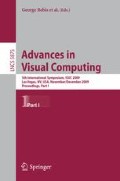Abstract
In this paper, we describe a nuclei segmentation algorithm for Pap smears that uses anisotropic dilation for curve closing. Edge detection methods often return broken edges that need to be closed to achieve a proper segmentation. Our method performs dilation using Riemannian distance maps that are derived from the local structure tensor field in the image. We show that our curve closing improve the segmentation along weak edges and significantly increases the overall performance of segmentation. This is validated in a thorough study on realistic synthetic cell images from our Pap smear simulator. The algorithm is also demonstrated on bright-field microscope images of real Pap smears from cervical cancer screening.
Access this chapter
Tax calculation will be finalised at checkout
Purchases are for personal use only
Preview
Unable to display preview. Download preview PDF.
References
WHO: Comprehensive cervical cancer control: A guide to essential practice. WHO Press (2006)
Grohs, H., Husain, O. (eds.): Automated Cervical Cancer Screening. IGAKU-SHOIN Medical Publishers, Inc. (1994)
Canny, J.: A computational approach to edge detection. IEEE Trans. Pattern Analysis and Machine Intelligence 8, 679–698 (1986)
Do Carmo, M.: Riemannian Geometry. Birkhäuser, Boston (1992)
Prados, E., Lenglet, C., et al.: Control theory and fast marching techniques for brain connectivity mapping. In: Proceedings of the IEEE Conference on Computer Vision and Pattern Recognition, New York, NY, vol. 1, pp. 1076–1083. IEEE, Los Alamitos (2006)
Jeong, W.K., Fletcher, P., et al.: Interactive visualization of volumetric white matter connectivity in dt-mri using a parallel-hardware hamilton-jacobi solver. IEEE Transactions on Visualization and Computer Graphics 13, 1480–1487 (2007)
Tsai, R., Zhao, H., Osher, S.: Fast sweeping algorithms for a class of hamilton-jacobi equations. SIAM journal on numerical analysis 41, 673–694 (2004)
Bouaynaya, N., Charif-Chefchaouni, M., Schonfeld, D.: Theoretical foundations of spatially-variant mathematical morphology part 1: Binary images. IEEE Transactions on Pattern Analysis and Machine Intelligence 30, 823–836 (2008)
Breuss, M., Burgeth, B., Weickert, J.: Anisotropic continuous-scale morphology. In: Pattern Recognition and Image Analysis, Pt 2, Proc., Berlin, Germany, vol. 2, pp. 515–522 (2007)
Udupa, J., LeBlanc, V., et al.: A framework for evaluating image segmentation algorithms. Computerized Medical Imaging and Graphics 30, 75–87 (2006)
Gonzalez, R., Woods, E.: 9. In: Digital Image Processing, 3rd edn., pp. 633–635. Pearson Education, London (2008)
Ghita, O., Whelan, P.: Computational approach for edge linking. Journal of Electronic Imaging 11, 479–485 (2002)
Ikonen, L.: Pixel queue algorithm for geodesic distance transforms. In: Andrès, É., Damiand, G., Lienhardt, P. (eds.) DGCI 2005. LNCS, vol. 3429, pp. 228–239. Springer, Heidelberg (2005)
Verbeek, P., Verwer, B.: Shading from shape, the eikonal equation solved by grey-weighted distance transform. Pattern Recognition Letters 11, 681–690 (1990)
Sochen, N., Kimmel, R., Malladi, R.: A general framework for low level vision. IEEE Transactions on Image Processing 7, 310–318 (1998)
San Jose Estepar, R.: Local Structure Tensor for Multidimensional Signal Processing. Applications to Medical Image Analysis. PhD thesis, University of Valladolid, Spain (2005)
Knutsson, H.: A tensor representation of 3-D structures. Poster presentation of 5th IEEE-ASSP and EURASIP Workshop on Multidimensional Signal Processing, Noordwijkerhout, The Netherlands (1987)
Bigün, J., Granlund, G.H.: Optimal orientation detection of linear symmetry. In: IEEE First International Conference on Computer Vision, London, Great Britain, pp. 433–438 (1987)
Förstner, W., Gülch, E.: A fast operator for detection and precise location of distinct points, corners and centres of circular features. In: Proc. ISPRS Intercommission Workshop, pp. 281–304 (1987)
Perlin, K.: An image synthesizer. In: SIGGRAPH 1985: Proceedings of the 12th annual conference on Computer graphics and interactive techniques, New York, USA, vol. 19, pp. 287–296 (1985)
Dietterich, T.: Approximate statistical tests for comparing supervised classification learning algorithms. Neural Computation 10, 1895–1923 (1998)
Luengo Hendriks, C.L., van Vliet, L.J., Rieger, B., van Ginkel, M.: DIPimage: a scientific image processing toolbox for MATLAB. Computer Program (1999)
Author information
Authors and Affiliations
Editor information
Editors and Affiliations
Rights and permissions
Copyright information
© 2009 Springer-Verlag Berlin Heidelberg
About this paper
Cite this paper
Malm, P., Brun, A. (2009). Closing Curves with Riemannian Dilation: Application to Segmentation in Automated Cervical Cancer Screening. In: Bebis, G., et al. Advances in Visual Computing. ISVC 2009. Lecture Notes in Computer Science, vol 5875. Springer, Berlin, Heidelberg. https://doi.org/10.1007/978-3-642-10331-5_32
Download citation
DOI: https://doi.org/10.1007/978-3-642-10331-5_32
Publisher Name: Springer, Berlin, Heidelberg
Print ISBN: 978-3-642-10330-8
Online ISBN: 978-3-642-10331-5
eBook Packages: Computer ScienceComputer Science (R0)

